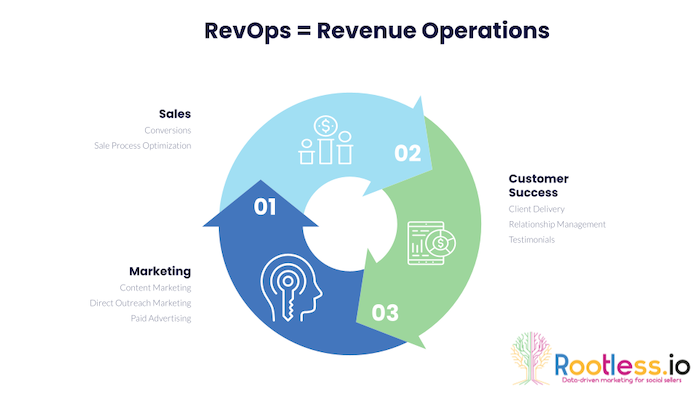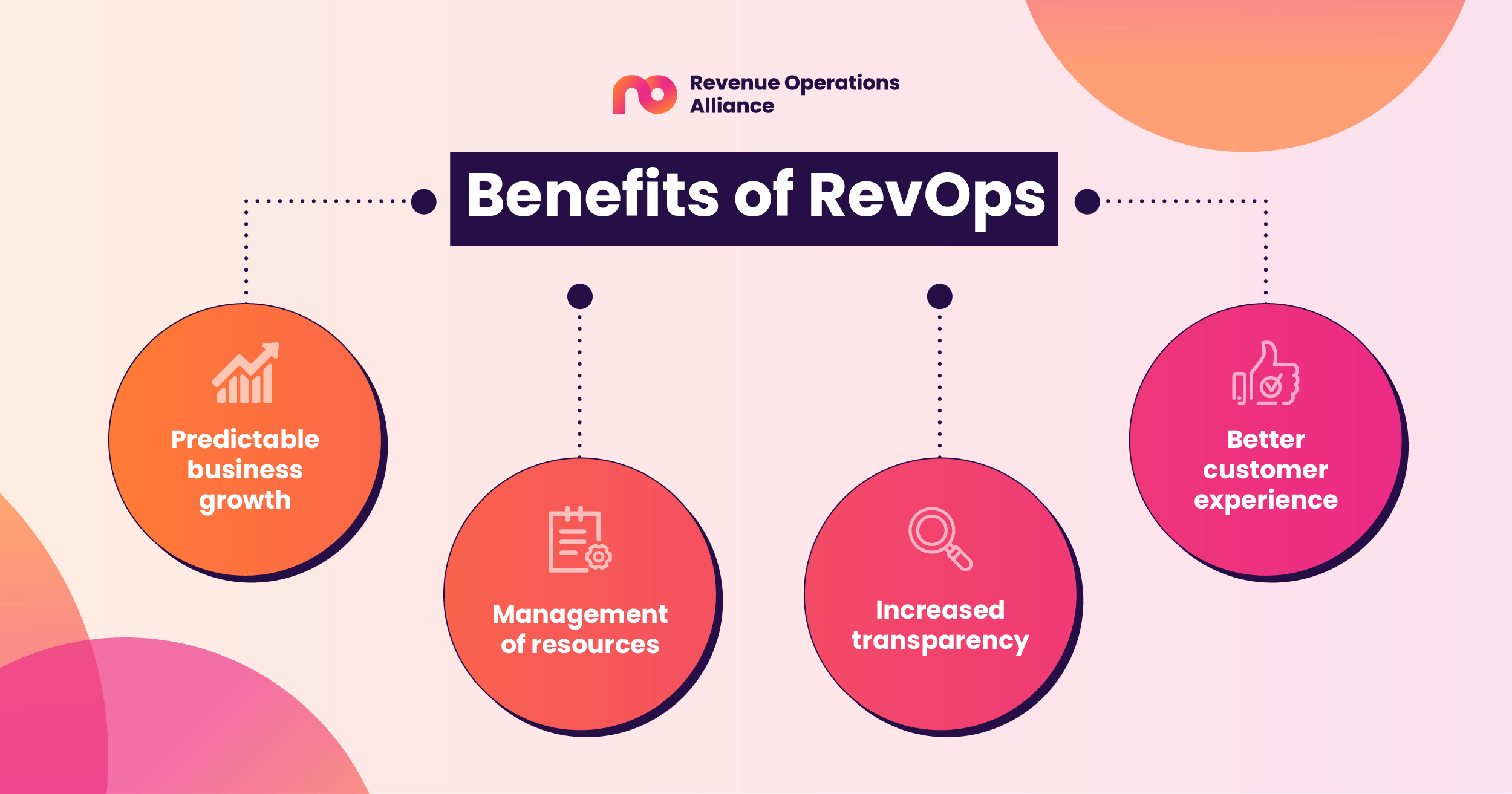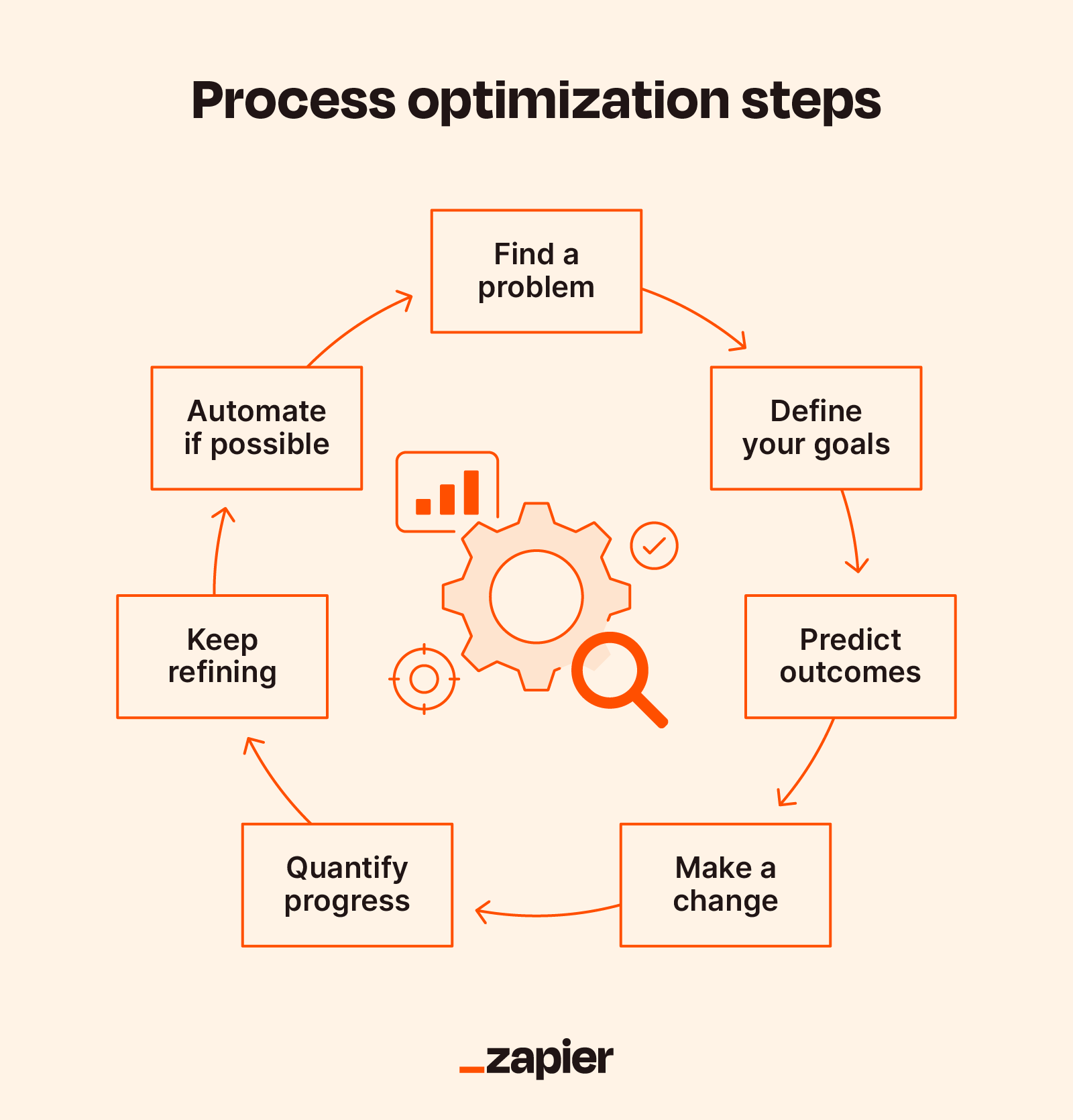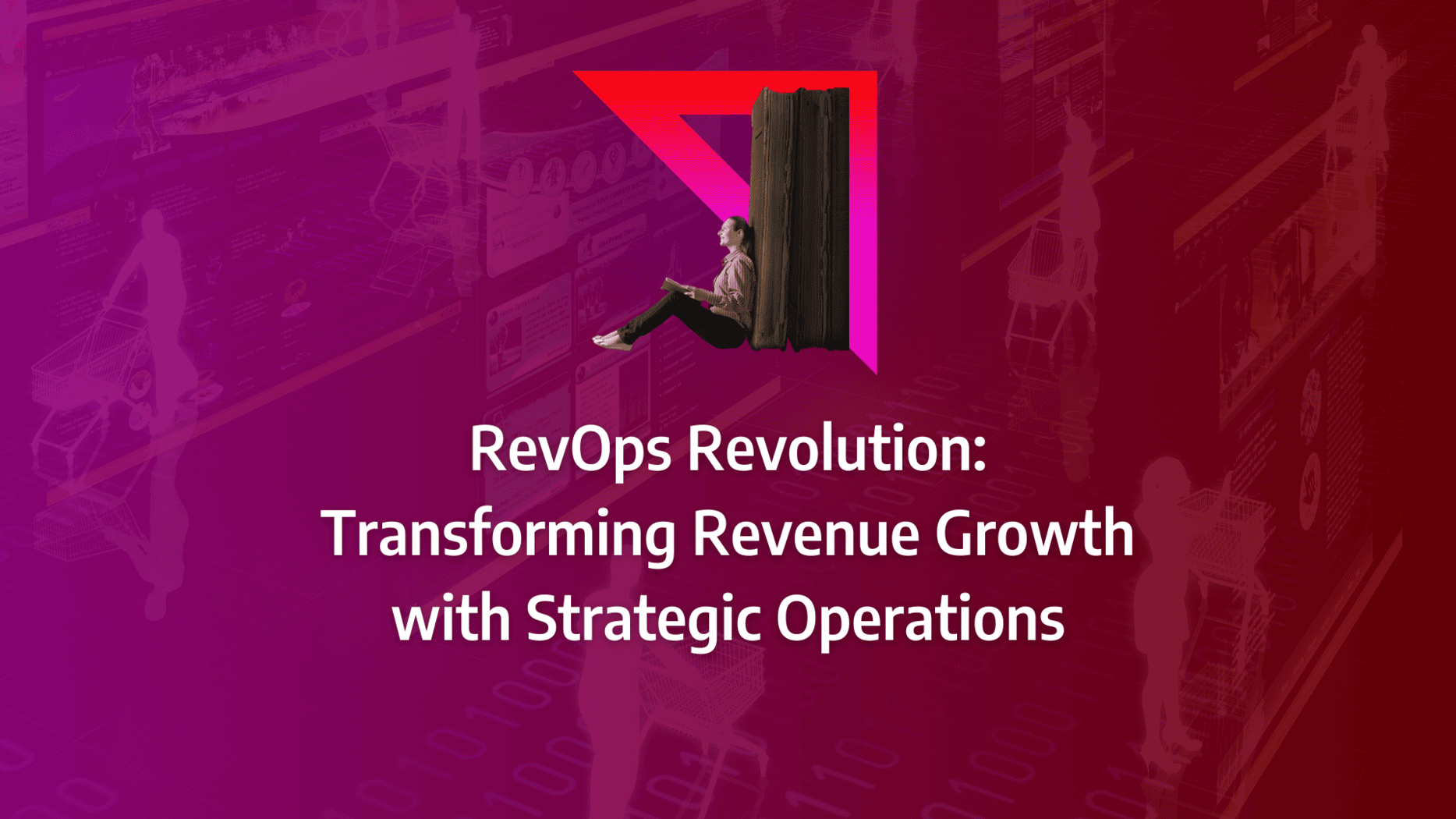Disjointed sales, marketing, and customer success operations can be a significant roadblock to sustained revenue growth. RevOps—or Revenue Operations—emerges as the strategic solution to this pervasive issue, offering a unified framework that aligns all revenue-generating teams under a common goal.
Imagine breaking down those silos and creating a seamless flow of information and strategy across your organisation.
- Unified Strategy: RevOps integrates sales, marketing, and customer success under a single strategy, fostering alignment and efficiency across teams.
- Data-Driven Decisions: Leverage RevOps to enhance data-driven decision-making, ensuring accurate revenue forecasting and strategic planning.
- Break Down Silos: Implement RevOps to dismantle departmental silos, enabling seamless communication and collaboration.
- Technology Integration: Use specific tools like CRM systems and revenue intelligence platforms to support your RevOps framework.
Revenue operations (RevOps) is a critical business function designed to align and integrate sales and revenue goals across marketing, sales, and customer success teams. By providing complete visibility across the entire revenue team and throughout the customer lifecycle, a business can optimise its sales and marketing funnel, attract higher-quality leads, and ultimately drive significant revenue growth.
However, it’s crucial to understand that RevOps isn’t a completely new concept. It hasn’t simply appeared out of nowhere. In fact, the foundational elements of RevOps have existed in various forms for some time, albeit without the formal title. Now, RevOps has become one of the fastest-growing job functions within SaaS and B2B companies, reflecting its increasing importance.
The Key Players in RevOps
At its core, RevOps is about alignment—ensuring all departments are working towards shared goals. But who exactly are the key players involved? Typically, RevOps brings together individuals from marketing, sales, customer success, and leadership. Let’s explore each of these roles in more detail.
1. The Marketing Team
In the RevOps framework, the marketing team is responsible for driving outreach efforts and engaging potential customers through targeted advertising and campaigns. However, a crucial aspect of a successful RevOps execution is that marketing must go beyond just the initial conversion. The relationship with the customer doesn’t end at the point of sale—authentic engagement must continue throughout the entire customer journey.
This is where the need for honesty and personalisation comes into play. In today’s market, authenticity is non-negotiable. Marketing teams must focus on building long-term relationships by delivering personalised experiences that resonate with the audience, ensuring the communication remains transparent and meaningful even after the sale.
2. Sales and Customer Success
While sales and customer success may traditionally operate as separate functions, in the revenue operations structure, these teams are tightly interconnected. Sales focuses on closing deals, but customer success is involved much earlier in the process, ensuring a seamless handoff before the sale is even finalised.
A proactive approach from the customer success team is essential in RevOps implementation. By engaging with potential customers before they’ve even committed, customer success can address any concerns early and set the foundation for a lasting relationship. Post-sale, the focus shifts towards ensuring customers are successful in using the product, which in turn drives retention and supports business growth.

3. The Leadership Role
Finally, RevOps requires strong leadership to unify all these moving parts. Typically, this role is filled by a Revenue Operations Manager, or in more advanced organisations, a Chief Revenue Officer (CRO). In some cases, CEOs or CMOs may also take on this responsibility, depending on the company’s structure.
The RevOps leader is tasked with overseeing the entire revenue process and ensuring that the different teams are aligned towards common goals. This involves a deep understanding of key metrics and the ability to manage cross-departmental challenges. Successful RevOps execution relies heavily on a leader who can bridge gaps between teams and ensure that everyone remains focused on shared outcomes, ultimately driving the business forward.
What Matters Most?
From our experience, building a RevOps culture that prioritises cross-departmental collaboration can significantly enhance operational efficiency. We often find that leveraging technology for deeper customer insights, rather than merely for automation, drives more informed decision-making. Additionally, integrating product management into the RevOps strategy typically creates alignment that benefits both marketing and sales, leading to more cohesive and effective campaigns.Get In Touch
What Are the Benefits of Implementing a RevOps Strategy?
Implementing a RevOps strategy can significantly enhance how your organisation operates, particularly in how sales, marketing, and customer success teams collaborate. Below, we break down the key benefits that come with adopting a robust RevOps framework.
1. Increased Revenue
A well-executed RevOps strategy can lead to substantial revenue growth. By aligning sales, marketing, and customer success teams, RevOps ensures a seamless flow of information and cohesive strategies that maximise revenue opportunities.
This alignment optimises the entire customer journey, enabling businesses to identify new revenue streams and improve retention rates, which directly results in increased profitability. In fact, Forrester Consulting found that companies with advanced RevOps strategies achieved up to 10% higher revenue growth over five years.
2. Improved Customer Experience
One of the main objectives of a RevOps implementation is to create a unified, customer-centric approach across all departments. This means delivering a seamless and consistent experience at every touchpoint of the customer journey.
When departments are aligned, businesses can offer an improved customer experience, which not only boosts customer satisfaction but also fosters long-term loyalty.
3. Enhanced Efficiency
By standardising processes and breaking down departmental silos, RevOps significantly improves operational efficiency. When workflows are streamlined, teams can focus their efforts on revenue-generating activities rather than getting bogged down by internal miscommunication or duplicated efforts.
This enhanced efficiency also reduces costs and frees up time for both sales and marketing teams to focus on strategic tasks that drive growth.

4. Better Data Insights
RevOps facilitates better data collection and analysis by centralising the management of revenue-related data. With access to more accurate and comprehensive data, businesses can gain deeper insights into customer behaviour and identify key areas for improvement.
This data-driven approach allows for more informed decision-making and optimises long-term revenue strategies.
5. Increased Agility
A flexible and agile RevOps execution is essential for staying competitive in today’s fast-paced market. By adopting a dynamic RevOps approach, companies can quickly adapt to changing customer needs and evolving market conditions.
This adaptability helps businesses stay ahead of competitors and seize new opportunities as they arise, ensuring long-term success.
6. Improved Communication
RevOps acts as the glue that holds sales, marketing, and customer success together. A centralised team overseeing all revenue operations ensures improved communication and collaboration between departments.
With clearer communication channels, misunderstandings are reduced, and overall performance is enhanced, leading to a more cohesive revenue operations structure.
What is Sales Operations (SalesOps)?
Sales operations (SalesOps) equips sales departments with the necessary systems, technology, and resources to meet their sales goals and contribute to accurate revenue forecasting. While SalesOps focuses on optimising sales activities, it also plays a critical role in ensuring precise revenue management through data-driven practices.
SalesOps leaders concentrate on improving sales processes, leveraging software tools, and creating greater visibility across departments. With the right systems in place, they can provide timely and accurate data that informs better revenue and pipeline forecasting, financial planning, and overall business growth.
What Does Sales Operations Do?
Sales Operations teams carry out a variety of essential functions that drive sustainable growth. While the exact scope may vary depending on the size of the organisation, the key functions typically include:
- Territory planning
- Sales forecasting
- Managing operational tasks
- Handling sales data
- Guiding user onboarding
- Overseeing sales commission data and incentive programmes
By optimising these sales processes, Sales Operations plays a vital role in enhancing a company’s revenue potential and fostering long-term growth.
What is the difference between sales ops and RevOps
The primary distinction between Revenue Operations and Sales Operations lies in their scope. While SalesOps focuses exclusively on the sales function, Revenue Operations is responsible for aligning multiple departments—sales, marketing, and customer success—to foster business growth.
In essence, Sales Operations is a subset of Revenue Operations. A RevOps framework enables companies to gain cross-departmental visibility and improve overall efficiency. When a Revenue Operations structure is implemented, Sales Operations can better target sales efforts, while the collected data informs more accurate forecasting and planning.
What does a Revenue Management strategy include
Implementing a RevOps framework in a SaaS scale-up requires a structured, strategic approach. Below is a step-by-step guide to ensure your business achieves maximum alignment and revenue growth through effective RevOps execution.
1. Define Your Goals: The foundation of any successful RevOps strategy is setting clear business goals. Start by identifying the key metrics and objectives your business needs to track to drive growth. Whether your focus is on increasing revenue, improving customer retention, or optimising operational efficiency, defining these goals will guide the entire RevOps implementation process.
2. Assess Your Current Operations: Before you can make improvements, you need a thorough understanding of where your current revenue operations stand. Conduct a comprehensive analysis of your existing processes, data, and team structures. This step is critical for identifying inefficiencies and areas for optimisation within your revenue operations structure. Only by understanding the gaps can you make informed decisions that will elevate performance.
3. Define Your Revenue Engine Funnel: A core component of the RevOps framework is the revenue engine funnel, which outlines the stages and processes involved in generating revenue. Clearly define your funnel by pinpointing the key stages, such as lead acquisition, nurturing, and conversion, that you will track and optimise. Mapping out these stages and associated metrics will help ensure that each phase of the customer journey is optimised for maximum impact.
4. Integrate Teams: In an effective RevOps framework, cross-functional team integration is non-negotiable. By aligning sales, marketing, and customer success teams, you eliminate silos and foster collaboration that is critical for sustained revenue growth. Studies show that businesses with integrated revenue operations teams have higher customer retention rates and lower churn, as collaboration ensures a more seamless customer experience. Therefore, a key aspect of RevOps execution is ensuring these teams work closely together towards unified revenue goals.
5. Optimise Processes: Continuous process optimisation is at the heart of any successful RevOps strategy. This involves leveraging data and analytics to identify areas for improvement in key processes such as lead generation, conversion rates, and customer retention. By continuously refining these processes, you’ll increase operational efficiency and drive better results over time. Regularly reviewing and optimising your operations is essential for staying agile and competitive in a fast-evolving marketplace.
Source: Revenue.io
Building a RevOps Team
Revenue Operations (RevOps) is an essential and rapidly expanding field that enables businesses to maximise their revenue potential by aligning and optimising the processes across sales, marketing, and customer success. To create a successful RevOps framework, it’s crucial to build a strong team by identifying the right roles, carefully hiring and onboarding talent, and fostering effective collaboration and communication.
Identifying the Right Roles
The first step in building a successful RevOps team is identifying the appropriate roles. Look for individuals who have a deep understanding of the processes and interactions between sales, marketing, and customer success. Ideally, candidates should possess experience in a revenue-generating role, with a proven ability to bridge the gaps between departments.
For instance, a Revenue Operations Manager needs to have a solid grasp of the customer journey, how to measure outcomes, and how to use feedback to improve operations. They must be adept in sales forecasting and have a strong foundation in analysing customer data to guide critical business decisions. A well-rounded revenue operations structure should also include roles such as Sales Operations Manager, Marketing Operations Manager, and Customer Success Operations Manager to ensure all revenue-generating functions are integrated and optimised.
Hiring and Onboarding RevOps Talent
When it comes to hiring and onboarding RevOps talent, it’s vital to take a deliberate and strategic approach. The ideal candidates should not only have a cross-functional mindset but also be capable of working cohesively across departments. This ensures they can contribute to a successful RevOps execution.
The onboarding process should provide new hires with access to comprehensive resources that will help them understand the complexities and interactions between the various roles and departments within the company. Establish a mentorship programme where new team members can work alongside experienced RevOps professionals to gain insights and guidance. Continuous feedback and training are essential to help them learn how to balance the often competing interests within the broader organisation.
Fostering Collaboration and Communication
Effective communication and collaboration are vital to the success of any RevOps strategy. It’s essential to implement communication tools and systems—such as Slack or Microsoft Teams—that allow the various teams to collaborate seamlessly, even in a virtual space. Additionally, fostering a collaborative environment with shared workspaces can help break down silos and create a unified team culture.
Regular meetings and check-ins are crucial to keep everyone aligned with the company’s overarching goals. Encourage open communication and invite feedback to ensure that all perspectives are considered. A performance management system that aligns with the company’s strategic objectives will also help ensure that each team member is contributing to the broader goals of the RevOps implementation.
What does a RevOps specialist do
RevOps Specialist Role
In the evolving landscape of business operations, Revenue Operations (RevOps) has emerged as a critical function, with a growing number of specific roles dedicated to supporting revenue generation. Below, we explore the common RevOps-specific job titles and the key responsibilities of a RevOps specialist.
Common RevOps-Specific Job Titles
As RevOps continues to develop, certain job titles have become standard across many organisations, while others may vary based on company size and structure. These roles are crucial in ensuring that revenue operations are managed effectively.
Revenue Operations Analyst/Specialist
Typically an entry-level position, a Revenue Operations Analyst or Specialist often has a background in a specific area such as sales or customer success. Their primary role is to support and improve processes within their area of expertise. Analysts are usually embedded within one or two branches of the go-to-market teams, providing data analysis and process improvement support.
Given the rising demand for this role, a quick search on ZipRecruiter reveals more than 287,000 open positions for Revenue Operations Analysts or Specialists.
Revenue Operations Manager
A Revenue Operations Manager is generally someone with experience in RevOps, sales operations, or broader business operations. Their role involves optimising internal processes and managing teams to foster collaboration and drive efficiency. Managers typically research and identify areas for improvement, then implement solutions to enhance performance.
The RevOps specialist plays a pivotal role in ensuring that a business’s revenue operations are aligned and functioning at their best. Below are the core responsibilities of a RevOps specialist and the impact they have on business growth.
1. Aligning Sales, Marketing, and Customer Success
A key responsibility of a RevOps specialist is to ensure alignment between sales, marketing, and customer success teams. By bringing these departments together under common revenue goals, the RevOps specialist helps to break down silos and foster seamless communication.
Impact: This alignment creates a cohesive approach to revenue generation, which not only improves communication across departments but also enhances overall business efficiency.
Source: Revenue.io
2. Data Analysis and Reporting
Another critical function of the RevOps specialist is data analysis. By collecting and analysing data from various sources, they provide actionable insights that inform decision-making across the revenue cycle.
Impact: Data-driven decisions improve operational efficiency and help drive revenue growth by identifying key areas of improvement.
3. Technology Management
A RevOps specialist also oversees the selection and implementation of tools and technologies that support the revenue operations function. They ensure that the team is equipped with the best tools to streamline processes and maximise productivity.
Impact: The right technology enables smoother workflows, reducing bottlenecks and increasing overall efficiency.
4. Process Optimisation
A significant part of the RevOps specialist’s role is identifying and implementing process improvements. By continuously refining the processes involved in the revenue cycle, they enhance customer experiences and reduce operational redundancies.
Impact: Streamlining operations ensures that the business can deliver better customer experiences while driving sustainable growth.

5. Training and Development
Providing ongoing training and development for teams is another key responsibility of the RevOps specialist. They ensure that staff remain up-to-date with the latest tools, strategies, and best practices, fostering a culture of continuous learning.
Impact: Regular training empowers teams to perform at their best, ensuring that they are fully equipped to drive revenue growth.
6. Forecasting and Planning
The RevOps specialist also plays a crucial role in revenue forecasting and strategic planning. By analysing historical data and current trends, they contribute to more accurate forecasting and help shape the company’s long-term revenue strategy.
Impact: This ensures that operations are aligned with broader business goals, helping the company make informed strategic decisions.
7. Compliance and Risk Management
Finally, the RevOps specialist ensures that the company remains compliant with laws and regulations. This involves managing risk and ensuring that the business follows industry standards and regulatory requirements.
Impact: Compliance minimises the risk of legal issues, protecting the company’s reputation and building trust with both customers and stakeholders.
Our Tactical Recommendations
Implementing structured lead generation processes that align with sales goals ensures a steady flow of opportunities. Clients often discover the value of utilising revenue attribution models to accurately measure marketing effectiveness, which leads to better resource allocation. Regular alignment meetings between sales and marketing teams are crucial; they foster clarity on goals and strategies.Get In Touch
Best Practice RevOps Tactics
To truly maximise the impact of your RevOps framework, it’s crucial to strike the right balance between radical transformation and steady optimisation. While dramatic overhauls might seem tempting, a lot of revenue can be unlocked simply by refining what’s already working. Below are some key RevOps tactics that can make an immediate difference to your bottom line.
Optimise Existing Revenue Channels: RevOps isn’t just about launching new initiatives; it’s also about refining what’s already contributing to your revenue. Even if your current sales channels are performing, they’re likely leaking revenue in some areas.
Overburdened Sales Reps: As lead volumes rise, sales reps often find themselves stretched thin. With limited hours in the day, they’re forced to prioritise who to engage, often leaving qualified leads unattended. Implementing lead routing workflows can resolve this. These workflows ensure that only the most relevant leads are routed to sales reps, allowing them to focus their efforts where it matters most.
Faulty Lead Qualification: Lead scoring can be a challenge for many businesses. Without the right formula, companies often end up with irrelevant scores that do little to help the sales team prioritise prospects. A tailored lead scoring system, such as the “RevZet” model developed by RevOps Automated, can provide a more accurate assessment of which leads are likely to convert, ensuring that sales efforts are directed efficiently.
Ineffective Follow-Ups: Even with a well-structured sales process, following up with leads consistently can be difficult. When your CRM is cluttered with leads in varying stages, it becomes even more of a challenge. The best way to overcome this is by setting up automated sequences for leads that aren’t immediately engaged by the sales team. This ensures that no opportunity slips through the cracks.
Addressing Technical Hiccups: Technical issues can silently sabotage your RevOps efforts. You may have a robust process in place, but without consistent monitoring, a simple workflow error could go unnoticed for weeks. Regular checks on your systems and workflows can prevent these hiccups from derailing your revenue operations.
Focus on 2-3 Key Objectives: It’s easy to get overwhelmed by the multitude of potential growth areas. Rather than trying to tackle everything at once, it’s critical to narrow your focus to the 2-3 core KPIs that will drive the most value for your business. Each of these key objectives should be paired with specific action plans that ensure you hit your quarterly targets. By narrowing your focus, you ensure that resources are allocated effectively and goals are more achievable.
Maintain Margins as You Scale: While some companies may take a “growth at all costs” approach, not every business can afford such risks. RevOps enables steady growth without sacrificing profit margins. By keeping your operating costs manageable and staying focused on core objectives, you can retain more revenue as you scale.
To maximise your impact, consider adopting frameworks such as Sales-Led Growth (SLG) and Product-Led Growth (PLG). Both approaches highlight the importance of customer success, particularly post-sale, as happy customers lead to greater retention and upsell opportunities.
Automate Repetitive Processes: Automation is one of the most powerful tools in the RevOps arsenal. Processes that are repeated frequently, like marketing nurture campaigns or lead follow-up emails, should be automated wherever possible. Automating these areas frees up your team’s time to focus on more strategic tasks, while also ensuring consistency in execution.
Data Maintenance is Key: In the world of sales and marketing, data has a relatively short shelf life. Poor tracking can further compromise the quality of your historical data, making it less reliable for strategic decisions. Regular data audits are essential for ensuring accuracy and maintaining the confidence of all departments. By keeping your data clean and up-to-date, you’ll enable better forecasting and more precise decision-making.







